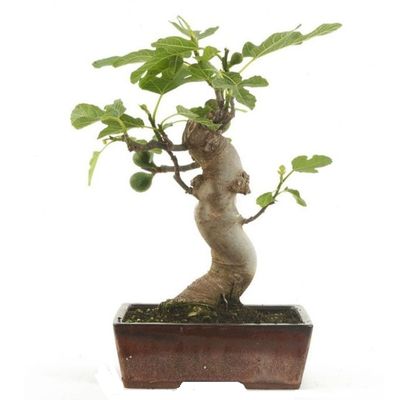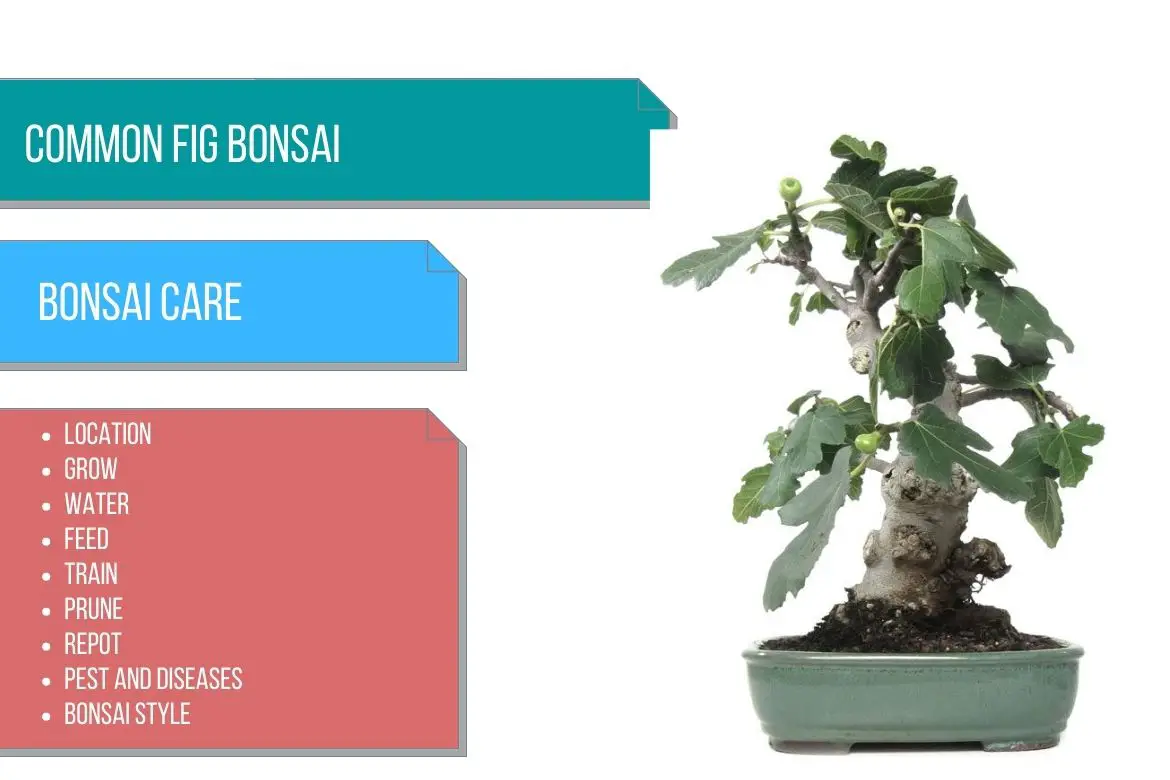
Common fig
( Ficus carica )
Country of Origin : West Asia & Mediterranean
Bonsai Styles : Formal upright, Informal upright
Zone : 8 – 10
The common fig (Ficus carica) is a deciduous tree.
It is one of the many varieties of ficus that can be used to make a bonsai tree.
When young, the trunk of the tree is quite slender and the branches are irregular and delicate. However, with age, you can achieve a thicker trunk in your bonsai.
Additionally, older bonsai specimens have strikingly long and remarkably thick branches that droop to the ground because of their own weight.
Ash-gray in color, the bark of the tree is quite thin, and smooth. Tree trunks remain smooth even when they are older.
Alternate leaves have between three and five lobes enlarged at the extremities with serrated margins. On the upper side, the leaf is rough, while on the underside, it is soft and downy.
These leaves emerge in the spring and are quite large for a bonsai. During the fall season, leaves are shed.
This tree is a lovely bonsai specimen, and in the fall it produces edible fruits from its inconspicuous flowers. The fruits ripe in summer. It is also a great indoor bonsai tree.
Read more about other pine tree bonsai in : Bonsai tree care .

Its large leaves make the common fig suitable for cultivation as a bonsai only under certain circumstances.
There are deeply serrated and relatively large leaves on this bonsai, but they can be significantly reduced in size if the plant remains in the same container for an extended period of time, leading to the bonsai having more proportional leaves.
The leaves of the tree become smaller and smaller as the number of branches increases and the bonsai reaches a certain height.
Best location to keep Common fig Bonsai
The Ficus carica bonsai tree loves full sunlight, especially if it is grown outdoors. It is a good idea to take the bonsai tree outside in mid spring and place it in full sun for as long as possible.
The bonsai container should be brought indoors in early fall before the first frost.
In order for the bonsai to start its dormant period, it should be kept at a temperature between 41°F and 46°F (5°C and 8°C) or even slightly lower.
The less light the bonsai gets during the winter, the colder the temperatures should be.
A sunny, well-ventilated area near a (west or south facing) window is necessary if the bonsai is kept indoors all year.
IMP: Refer sunlight requirements for indoor plants for more indoor gardening ideas. Also, refer to do bonsai trees need sunlight for more indoor and outdoor bonsai location ideas.
Propagation of Common fig
Common fig can be propagated using soft wood or hardwood cuttings in spring, before the new buds open. Take a cutting (with at least 2 nodes) of length 8-12 inches.
Apply rooting hormone and plant the cutting in a potting medium. Keep the pot in a warm place.
These trees can also be propagated using seeds.
The seeds can be obtained from the fruits, which should be soaked in water for a few days so that the flesh can easily be removed.
Afterwards, the seeds can be sown immediately. Keep the potting medium warm. In about 1-2 weeks you can see germination.
Watering Common fig Bonsai
During the summer months, the bonsai should be watered generously in order to keep it healthy.
It is best to wait until the leaves start to droop a little bit before watering your bonsai if you wish to keep them small.
You should water the tree sparingly in the winter if it is in a cool location, but do not allow the soil to dry out completely.
In the dormancy period, when the leaves of the tree drop, reduce watering even more.
Tap water can also be used to water common ficus bonsai tree.
Read watering bonsai tree for more details.
Wiring Common fig Bonsai
In view of its thick branches, wire training a common fig bonsai can be a little challenging.
Thus, it is important to start wiring the Ficus carica bonsai as early as possible, while it is still young.
In spite of the fact that wiring can be done at any time of the year, the best time is just before the new shoots emerge in the spring.
It is easy to train branches that are one year old by wiring them.
Older branches, however, become inflexible over time and so they have to be guyed down so that the bark of the tree is not damaged.
Pruning Common fig Bonsai
When to prune Common fig bonsai?
How to prune Common fig bonsai?
It is possible to vigorously cut back Ficus carica bonsai throughout the year.
A new shoot can be pruned back to 2 to 3 leaves once it has developed 6 to 8 leaves.
During the summer, you may remove a number of large leaves, which will encourage the growth of smaller leaves and improve the branching of the tree.
It is essential that you drastically cut back all the previous year’s growth before the new leaves emerge in the spring.
If the tips of the shoots aren’t removed, no new branches will develop.
When pruning, a milky fluid will leak out of the pruning wounds.
If any cuts are made, they must be well sealed with a cut paste to prevent the remaining buds from drying out and to also prevent any kind of infection.
Repotting Common fig Bonsai
When to repot Common fig bonsai?
Young bonsai trees can be repotted every 2 years. And older bonsai specimens can be repotted every 3-4 years.
Repotting is best done in the spring, before new shoots appear.
The common fig tree bonsai tolerates vigorous root pruning well.
You can use a moist, free-draining, bonsai soil mix as a potting soil.
Or Compost, sand and fired clay particles in the ratio of 1:1:2.
Or A mix of peat moss, sand and loam in the ratio of 1:1:2.
Must Read: Bonsai Soil Recipes
Must read : Choosing the right bonsai container
Feeding Common fig Bonsai
An inorganic liquid fertilizer should be applied weekly to young bonsai trees from early spring to autumn.
Bonsai trees that are older, more mature and whose leaves are to remain small should be fertilized about once a month.
Don’t fertilize during dormancy.
Read more about bonsai fertilizer and its application.
Diseases and pest of Common fig Bonsai
The common fig bonsai is sometimes attacked by scale insects, and Fig blister mites.
In addition to blisters on the surface of the leaves, fig blister mite will cause stunted twigs and leaves may drop from the trees.
You can apply horticultural oils or Neem oil to reduce the infestation. Sulfur sprays are highly effective against blister mites.
Make sure to apply any kind of chemical treatment before the tree blooms.
Fig rust can also occur on the tree. On the upper surface of the leaves, there are small, yellowish spots that enlarge and become reddish brown in color as they mature.
The fallen leaves and other plant debris should be collected and burned as soon as possible. Water should not be applied overhead or leaves should not be wetted. Make sure that there is proper air circulation around the plant at all times.
Common fig bonsai care
As stated earlier, do not water the trees from the top. This will prevent the leaves from getting wet and hence avoid infections.
Hot bright sunlight can cause scalding of leaves and even leaf loss.
Make sure they are placed somewhere where they won’t be affected by cold drafts from windows or doors.

